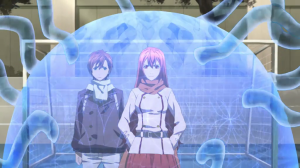What Films Can Teach Us: A Writing Exercise
by RadiumEyes, HSM team writer
In the seminal magical girl series Sailor Moon, Tsukino Usagi stumbles upon an unusual cat named Luna, who informs her that she holds the power of Sailor Moon, a powerful guardian of justice and order; Usagi initially shows great hesitation in accepting the role, as she happens to be a rather self-conscious high school girl prone to crying fits and tripping on her own feet.
She isn’t exactly “paragon of excellence” material when we first see her – she has trouble with school work, she constantly finds herself running late for school, and she spends much of her time reading manga and playing video games instead of tending to homework (which helps explain the first point). All in all, she represents the typical high school experience for Japanese students; she lives her life however she can, and tries her best to maintain a positive disposition while dealing with life’s little problems. When she became Sailor Moon, however, she now has a much greater social duty to uphold – defeating the forces of evil before they can defeat humanity, and what a lot these forces are.
The first season introduces us to the first of the antagonists, the Dark Kingdom; residing in a world of grotesque atmosphere, Queen Beryl rules over her subjects, and has her most trusted officers do the dirty work and collect energy. This follows a familiar formula – the antagonist conjures up a scheme to steal energy from unsuspecting humans (usually by preying on their vulnerabilities and emotional impulses), and the Sailor Scouts must intercept them before significant harm can be done, thereby restoring social order to Japan.
The show lasted for several seasons, with a new one on the way, and the Scouts face increasing danger as they confront new opponents and recruit new allies; Sailor Moon contains numerous references to Buddhist and Shinto concepts, including the concept of karma and dukka (the latter referring to suffering in various forms). Antagonists in this series represent the very real risks of succumbing to negative behaviors, as the villains never repent for their actions; the Scouts, by contrast, symbolize the good that humanity can achieve, if they work together for the good of society. Sacrifice and friendship are shown as blessings, not only through the continued triumphs of the Scouts, but through the celestial motifs – the moon, for example, represents the Buddha and his compassion, and its association with Sailor Moon gives a divine blessing to her actions. At the same time, Tsukino Usagi shows her complexity as a character; she’s human, after all, and can be influenced by the very negativity that she faces in on a regular basis. This critical aspect of Usagi shows that people can act in various ways, but good still resides in them; humans have the capacity for selflessness and sacrifice, and Sailor Moon learns that throughout the show that bears her name.
I raise this point because Sailor Moon taps into an essential part of the human condition – the capacity of social graces and friendship that all of us seek and hope to express. Through their actions, the Scouts present a complex tale of interaction wherein they must deal with their own internal struggles while simultaneously warding off a major antagonist group that threatens to unravel the social fabric around them; what can this say about social networks like Home or Avakin?
These applications don’t give us superhuman powers, but the core lessons remain – within every one of us resides a spark of kindness and gratitude that transcends any sort of emotional struggle or bad behavior that we might encounter in our day-to-day lives. Films and television shows alike reflect the societies they were created in – the same applies to any sort of entertainment or social medium, such as music, video games, or even places like Playstation Home. For the United States, we see the spirit of individuality and the search for identity in such films as Easy Rider and Citizen Kane – very different approaches to the subject of American life, but both films have valid arguments about what it means to live in the United States. Kane, for example, shows a cautionary tale of letting fame and fortune overwhelm you, to the point where you end up alone, in a crumbling house that represents your faded glory; Charles Foster Kane learned the hard way that money and fame cannot assure a good life, and he saw his relationships crumble around him. With Easy Rider, the search for the “real America” may be fruitless – what is America, exactly? Do the characters ever find a satisfactory answer to that question? Probably not, but their journey takes them across the nation; the film came out during a time when the counterculture movement was in full swing, and the more idealistic messages seen in films of previous decades gave way to a more critical assessment of where we, as a nation, stand.
But what of Home? Can we apply these themes and motifs to a network catering to an international audience? Indeed, we can, if we know how to apply our understanding of specific films well enough; take Citizen Kane, for example. The central figure of Kane is a mysterious figure, a larger-than-life presence whose true identity remains elusive, even after we see the individual testimonies of those close to him. Of the five characters interviewed by the reporter, they all present Kane in a different light; Susan Alexander saw Kane during a moment of vulnerability, and he became a domineering and angry individual in her eyes. For Jedediah Leland, one of Kane’s confidants in the newspaper business, the newspaper magnate was less hard-line, but still a powerful personage. To associate this with Home, think of how drama starts – people can inadvertently become unreliable narrators when telling a story, and friendships can strain momentarily over misunderstandings and miscommunication. The full narrative may be lost in the process, but there’s always time to reconcile; Kane never had that opportunity, and his friends and associates were left with faded memories of him.
As a bit of a fun exercise, think of a film, TV show, book or song that struck a chord with you, or made you think more deeply about a particular topic – something that had an underlying emotional value that helped you understand something a little more. It can be an old film with a message that still reverberates today (such as The Cabinet of Dr. Caligari and its unsettling undertones that speak of the influence of the more sinister side of humanity) or a classic book that spoke of social ills that remain an issue today (e.g., To Kill a Mockingbird and its themes of gender roles and class). Human society has no shortage of great works that have an analogue on social networks – even something as seemingly out-there as Plan 9 from Outer Space or Captain Blood can have valuable lessons within it, if one analyzes their contents. The only potential limitation is one’s creativity and ability to adapt a work to major social trends; as writers, we can find all sorts of inspirations for articles based on literature, filmed media, artwork or music, and the sky’s the limit. I’d love to see what can come out of this – the sheer amount of material that can be covered is astounding, and we can all find something to speak about through the lens of popular fiction.
To give one final example, Noragami features an ambitious minor kami (Shinto god) trying to make a name for himself by doing odd jobs for five yen a pop; he imagines himself having a grand shrine, with numerous attractive female attendants at his command, but that’s somewhat unrealistic. The major kami found in Shinto (many of whom became representations of Buddhist deities) have their own dedicatory shrines, with millions of people visiting them each year; they earned their place through their continued presence in the natural world, and the protagonist of Noragami has no such claim to his name.
This can speak of people who have the mistaken impression of a stratified Home society, where the “big names” become the benchmarks of a Home presence; this is a misconception, as it can lead someone to think that they have to be “better” than someone else, even though that other person became famous for showing gratitude and kindness towards others. Yato, Noragami’s protagonist, has the wrong idea in mind for kami-dom; he wishes for riches and fame, but the major deities obtained respect through their magnanimity and ability to answer prayers in a timely fashion. The kami may be capricious and unpredictable at times, but they still have respect – they didn’t lord themselves over humans, instead recognizing the importance of keeping a good rapport with others.
Share
| Tweet |






 Twitter
Twitter